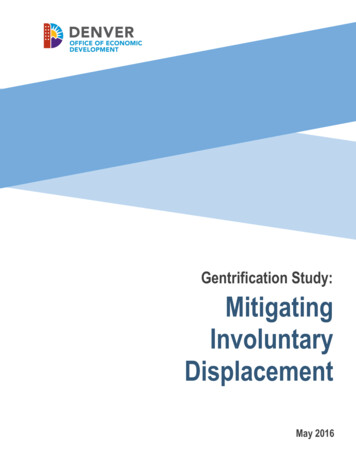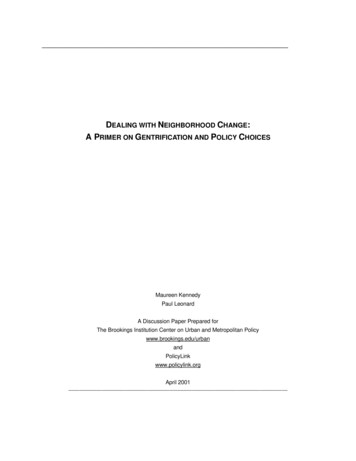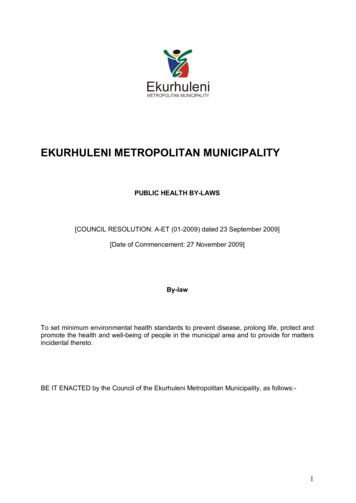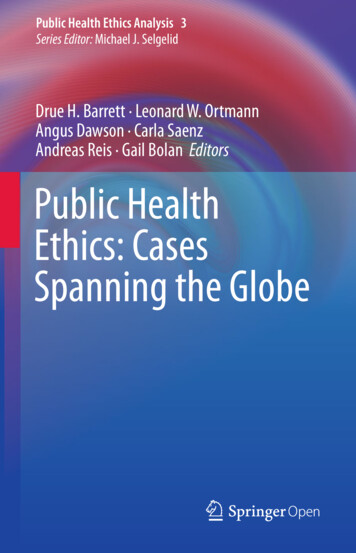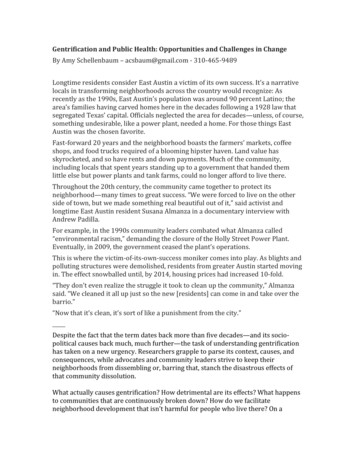
Transcription
Gentrification and Public Health: Opportunities and Challenges in ChangeBy Amy Schellenbaum – acsbaum@gmail.com - 310-465-9489Longtime residents consider East Austin a victim of its own success. It’s a narrativelocals in transforming neighborhoods across the country would recognize: Asrecently as the 1990s, East Austin’s population was around 90 percent Latino; thearea’s families having carved homes here in the decades following a 1928 law thatsegregated Texas’ capital. Officials neglected the area for decades—unless, of course,something undesirable, like a power plant, needed a home. For those things EastAustin was the chosen favorite.Fast-forward 20 years and the neighborhood boasts the farmers’ markets, coffeeshops, and food trucks required of a blooming hipster haven. Land value hasskyrocketed, and so have rents and down payments. Much of the community,including locals that spent years standing up to a government that handed themlittle else but power plants and tank farms, could no longer afford to live there.Throughout the 20th century, the community came together to protect itsneighborhood—many times to great success. “We were forced to live on the otherside of town, but we made something real beautiful out of it,” said activist andlongtime East Austin resident Susana Almanza in a documentary interview withAndrew Padilla.For example, in the 1990s community leaders combated what Almanza called“environmental racism,” demanding the closure of the Holly Street Power Plant.Eventually, in 2009, the government ceased the plant’s operations.This is where the victim-of-its-own-success moniker comes into play. As blights andpolluting structures were demolished, residents from greater Austin started movingin. The effect snowballed until, by 2014, housing prices had increased 10-fold.“They don’t even realize the struggle it took to clean up the community,” Almanzasaid. “We cleaned it all up just so the new [residents] can come in and take over thebarrio.”“Now that it’s clean, it’s sort of like a punishment from the city.”Despite the fact that the term dates back more than five decades—and its sociopolitical causes back much, much further—the task of understanding gentrificationhas taken on a new urgency. Researchers grapple to parse its context, causes, andconsequences, while advocates and community leaders strive to keep theirneighborhoods from dissembling or, barring that, stanch the disastrous effects ofthat community dissolution.What actually causes gentrification? How detrimental are its effects? What happensto communities that are continuously broken down? How do we facilitateneighborhood development that isn’t harmful for people who live there? On a
Monday in late April, a group of researchers and activists gathered on the 23rd floorof a Manhattan midrise, at the New York State Health Foundation headquarters, toask these questions, investigating themes that resonate here-and-now.At Columbia’s scientific symposium on gentrification and public health, put on bythe epidemiology department at the Mailman School of Public Health, researchersshared their own dissections of the origins and implications of gentrification, callingupon a spate of tools from the academics' arsenal: historic records, data mapping,statistical regressions, and potent stories from on-the-ground ethnographicresearch. Here, too, advocates shared their own findings about neighborhoodsfractured by gentrification.The task at hand was not to pin down a solution to the displacement of poorcommunities—though quite a few were discussed—but rather to braid disciplinesto inform researchers and organizers, and to contextualize their work. Thesymposium was about inspiring new collaborations and reiterating the importanceof studying every undulating tentacle of the topic.Gentrification is, to put it succinctly, the fragmentation or total displacement of acommunity caused by the influx of people of a higher socioeconomic and/orethnopolitical class. At the outset it's not all that complicated: when people orinstitutions with more money decide a piece of land is valuable, the onrush ofwealth drives up housing prices, squeezing out the neighborhood's originaldwellers.The effects of such a shift can be severe: epidemiologists and others in public healthhave long established the health woes of people whose lives have been uprooted.People often must leave their jobs and move into lesser-quality housing. These lifeevents are paid for by working more, or cutting out costs associated with medicalcare and healthy lifestyle choices. People in unstable housing are more likely tosuffer from HIV/AIDS. The psychological effects are long lasting and dire.Epidemiology researcher Dr. Rodrick Wallace made his point the most starkly:“Gentrification,” he said, “is ethnic cleansing.”To introduce the symposium, its hosts Dr. Mindy Fullilove, Dr. Robert E. Fullilove,and Dr. Gina Lovasi first presented a video by filmmakers Aubrey Murdock, MollyRose Kaufman, and Havanna Fisher. Spurred by the gentrification of UpperManhattan—particularly the construct of new luxury building in WashingtonHeights—“The Domino Effect” revisits the improvement of the nearby HighbridgePark, wondering for whom, exactly, did the city invest. The mini-documentarystudies the answers within the context of American urban planning.
The video presented the problem: that government policies dating back to the1890s set the stage for urban renewal, gentrification, and other forms of forceddisplacement. The narrative begins with Jim Crow laws, which, up North, translatedto banks and real estate companies limiting where blacks could live and openbusinesses, usually to neighborhoods with substandard living conditions. Itcontinues into the aftermath of the Great Depression, when the government decidedwhere to invest New Deal money based on factors like the number of foreign-bornresidents and people of color. Neighborhoods that were already neglected, ofcourse, were given the lowest scores, furthering disinvestment.Fast-forward a few decades, and the city labels some of these neighborhoods“slums,” using eminent domain to demolish swathes of housing and communitybuildings in favor of university infrastructure or shiny cultural centers. In the 1970s,planned shrinkage, which Fisher calls a “catastrophic form of disinvestment,”fomented the burning of neighborhoods through the closure of select firedepartments in poor, stressed neighborhoods throughout the city.In between, these communities have been further broken up by “highwaydevelopment, deindustrialization, mass criminalization, and the foreclosure crisis,”Fisher says in the documentary. Gentrification “is often viewed as a natural process,”but the long history of forced displacement indicates otherwise.Gentrification often comes hand-in-hand with the beautification of communities,like the rehabilitation of Highbridge Park. In the documentary, Fisher addresses thisoutright: “I do want my community to be improved, but not at the risk of it beingdestroyed.”‘The eve of mass displacement’Richard Marciano on Redlining and the New Deal.But let’s back it up. First up at Columbia’s symposium was the work of Dr. RichardMarciano, the director of the Digital Curation Innovation Center at the University ofMaryland. For his “Mapping Inequality” project, Marciano and his co-authorsscanned and quantified data from the Home Owners’ Loan Corporation, a New Dealprogram Franklin D. Roosevelt created to refinance mortgages to prevent massforeclosures in the years after the Great Depression.Over the next three decades, the U.S. government financed over 120 billion in newhousing, Marciano notes, though less than 2 percent of that real estate was availableto non-white families.Essentially, the HOLC put in place appraisal methods that kick-started a practiceknown as redlining, or the institutionalized denial of (or greater charge for)services.
The 1930s appraisals are painful to read, describing neighborhoods in terms of theirracial makeup and the immigration status of its inhabitants. What’s more,documents from that era explicitly discouraged realtors from “introducing anyindividuals whose presence will clearly be detrimental to property,” with thecapacity for detriment based largely on “race or nationality.”Elsewhere documents describe nonwhites as “adverse influences” thatneighborhoods needed “protection against.” A particularly horrifying part of theFederal Housing Administration underwriting manual in 1935 compares these“influences” to bad odors:Important among adverse influences are the following: infiltration ofinharmonious racial or nationality groups; the presence of smoke, odors, fog,etc.Using these appraisals, HOLC categorized neighborhoods into colors, with “red”neighborhoods “characterized by detrimental influences in a pronounced degree,undesirable population or infiltration of it.”By “redlining” neighborhoods, the government was cataloging where they weren’tgoing to send resources—decisions based largely on race, religion, and country oforigin. This, as Marciano said, “institutionalized exclusion.” From there thegovernment drew up secret residential “security maps” for U.S. metropolises.“It’s Third Reich-like, and it’s happening around the same time,” Marciano said.Marciano and his co-authors endeavored to digitize these maps, and succeeded inbuilding them using Google Maps, ultimately making neighborhood-specific datajust a click away with access to archived documents and other interactive elements.Perhaps unsurprisingly, the red areas of these maps aligned incredibly well (“fitslike a glove,” Marciano said) with maps of urban renewal projects that happeneddecades later. It’s not hard to see why: systematic neglect translates to less federalmortgage aid, fewer parks, and poor public schools. The denial of investmentcontributed to the slum-like conditions the federal government tried to eradicate inthe ‘50s and ‘60s.Urban renewal is what Marciano dubbed the “second act” of gentrification. In theUnited States it began in earnest with the Housing Act of 1949. By the 1960s,Harlem-born writer James Baldwin famously termed urban renewal “NegroRemoval,” as it had the effect of clearing away existing neighborhoods, andrebuilding with structures and services that were not accessible to prior residents.Marciano looks at the period by way of the changes seen in Asheville, NorthCarolina. He and his team pored over the city’s historic records from 1970, which
were transferred to UNC Asheville in 2007, and spoke to long-time residents, hopingto “recreate the face of the neighborhood on the eve of massive displacement.”Research unearthed what he called “a really vibrant African-Americanneighborhood,” one brimming with churches, parlors, funeral homes, and more. Asurban renewal of the 1960s and 1970s ran its course, real estate records show whatMarciano called “typical neighborhood vacation.”In contemporary Asheville, Marciano noted, “it’s a lunar landscape; there’s not ahouse you would recognize.” Everything—those small businesses and communitycenters—“has been removed.”It all, Marciano noted, comes back to redlining. “You can literally see the cumulativeimpact, the domino effect, of one policy after another. The redlined areas of the ‘30sand ‘50s exactly fit the areas that where removal occurred.”‘A vulgar, criminal intrusion’Trushna Parakh on the perception and effects of gentrification.To showcase the detrimental effects of gentrification, Trushna Parakh, an assistantprofessor of geography at Texas Southern University, presented vignettes from NewOrleans Tremé neighborhood to show differing perceptions of the demographicchanges happening in a historically black part of the city.George, a resident she interviewed, described the changes in terms of police activity,and how he “couldn’t move about the neighborhood freely without being stalked bythe police,” Parakh said. “Because he wasn’t in a car and he had an increasedpresence outside, he would be bothered by police. He was routinely harassedwithout any reason.”Gentrifiers, Parakh said, are “notorious for calling the police.” In the mind of newresidents, they are improving the neighborhood by calling the police. As onewealthier new resident told Parakh, ““I feel like I am much more proactive, youknow, I call the cops [ ] you know, I care about the community.”As new residents are also more likely to make noise complaints, gentrificationthreatens place-based culture, one defined in Tremé by its parades, bars, and livejazz. Certainly this scenario is echoed in other cities known for their musical history.“Loss goes well beyond displacement,” Parakh says, citing “the erosion of placebased knowledge and customs, loss of social networks, and the closure of vitalneighborhood institutions.”One of the residents she interviewed does not mince words, calling newcomers “avulgar criminal intrusion into our streets. [ They] come in, buy the houses—and
they look nice but there ain’t no spirit in the house. When the drums come, theydon’t come to the door and greet the people, they call the police.”‘800 houses demolished to make room for a shopping center and a doggy park’Marisela B. Gomez on John Hopkins in Baltimore.Community activist and public health professional Dr. Marisela B. Gomez calls thegrowing footprint of Johns Hopkins University “really vicious,” but that is just howdevelopment works in Maryland’s largest city. Gomez, who herself got her MedicalDegree, her Masters of Public Health, and her PhD at Johns Hopkins, calls it“rebuilding: Baltimore style.” Some people call Baltimore “Hopkins City,” she said,which “gives you a sense of where the power lies.”The expansion of Johns Hopkins into greater East Baltimore began with urbanrenewal in the 1950s. The rhetoric surrounding the expansion—then as it is now, inBaltimore as it is in New York and Austin and Los Angeles—was all jobopportunities and public works projects. Talk of helping the poor, Gomez insisted,“is just the bait.”“Then there’s the switch, once we get rid of the poor people, we have built thecommunity we want.” It’s a method that relies on fragmentation and fracturingsurrounding communities. Proof of the trick, she says, is simply that, when it comesto planning, “we don’t ask the community that’s there. We ask the community that’scoming in.”As for the introduction of jobs, the effects of serial forced displacement, and thecontinual break up of communities by way of government neglect outlined inMarciano’s research, mean “there is no employment opportunity,” because there’sno work force with the skills the university needs.“These people have a history of incarceration, they have drug-use history, they havenot participated in the educational system that allow all of us to participate,” Gomezsaid. “They have been fragmented, and not given that opportunity, so they can’tcompete.”‘The last clean up is us leaving.’Andrew J. Padilla on the consequences of shifting neighborhoods.Andrew J. Padilla has crafted a career out of documenting changing neighborhoodslike his own East Harlem. At the symposium, he spoke about his El Barrio Tours, andhow communities fight to determine their own fate.That quest for self-determination had duplicitous effects for East Austin, Texas,whose zip code considered the “second-most gentrified” in the country. Padilla, afilmmaker, interviewed community leaders last year, uncovering a troublesomenarrative: the more success community members had expelling polluting structures
the government inflicted upon East Austin, the closer the neighborhood inched togentrification, and the removal of the lifeblood of the community.Video footage from 1994 shows community leaders in the thick of their efforts toclean up the neighborhood. People Organized in Defense of Earth and her Resources,or PODER, was working to remove the 15-story Holly Street Power Plant, whichRobert Donley, then the chair of the Holly Street Power Plant Closure Committeecalled a “heath strain on the citizens of this community,” and an imposition on the“peace and tranquility” of the neighborhood.“I think the health of the citizens should be a higher priority than the cost of removalof the power plant,” Donley said in the 1994 footage.Susana Almanza said in 1994 “this is a clear case of environmental racism. The cityhas admitted that this is not a place a power plant should have ever been built. Ourchildren play here, they swim here. Our elderly are here.”It wasn’t just the power station, either. PODER, whose goal is to influencegovernment decisions regarding the health of people of color, recommendedrerouting six major transmission lines, getting rid of the tank farm, and more.Come 2009, PODER had pressured the city to replace the plant with a smaller,cleaner substation.“Back then [in 1994], I’d say the population was still, I would say, 90 percentLatino,” Almanza, now the director of PODER said in the video. There’s been a bigchange in the ethnic breakdown in this particular zip code. So yeah, a lot of peopleare no longer here.”Here’s why: 20 years ago a house “would cost you maybe about 18,000.” In 2015, anew house goes for 1.3 million— 269,961 comes from the initial down payment.PODER spent decades cleaning out its neighborhood, but success meant people fromWest Austin started crossing Highway 35 (the divider between “Anglo” Austin andthe Austin “of color”) to live on the other side.“They’re benefiting,” Almanza said. “I mean they’re benefiting from the struggle. [ ]It’s real painful because you work hard to clean up the community only to be pushedout of it.”“It’s sort of like a punishment from the city,” she said. “You no longer wanted to livewith polluting sites and made us shut down—well guess what? You’re not going tobe able to live there anymore.”As Padilla put it, “We cleaned it up, but the last cleanup is us leaving.”
‘The outcomes of gentrification depend on who’s asking’Angela A. Aidala on the health consequences for displaced communities.Of course, for politicians and real estate developers, gentrification has a verydifferent narrative. Dr. Angela A. Aidala, a research scientist at Columbia’sDepartment of Sociomedical Sciences, points out that these populations focus on theinvestments in amenities and healthy community resources, as well as the increasedsense of safety, property values, tax revenues, and even social mix (read: poverty isless concentrated). “Yes, it facilitates mixing—for a time.”Impacts for the original residents, however, are hard to ignore: rent increases areoften financed by cutting back on healthy food and medical care, or by workingmore hours. Residents may need to double-up in apartments or seek less expensive,poorer-quality housing. The negative mental and physical consequences of chronicstress aren’t hard to grasp. Aidala called insecurity and transience “brain poison,”and an inevitable evil if “your house is a constant source of stress and anxiety.”Gentrification disrupts social networks, including family relationships and divisionsof labor. It kills a sense of community (as Parakh illustrated) and scrubs areas oflocal culture, often shuttering small businesses. Shelters, food banks, drug centersand other social services are “NIMBY’d,” a term referring to residents complainingthat certain buildings should be built “not in my backyard.”Because outside communities have determined the land in gentrifyingneighborhoods is now of greater value, churches and other community centerscannot pay to stay. Relatedly, when asking pastors about the most important issuefacing the Harlem community, they answered unequivocally, even in 2004, “housingand development.”“Most of my parishioners [are] suffering form looking for affordable housing,” onesaid. Another: “Several elected officials talk about affordable housing but are doingnothing. Housing is too expensive. Seniors are fine but young working people arecatching hell.”Struggling with unstable housing, Aidala noted, has a tendency to make medicaltreatment and other health promotions particularly difficult. “I would argue thathousing and neighborhood are the predominate intermediary determinants ofhealth,” Aidala said, because “housing is a manifestation of income.”Housing and neighborhoods act as an amplifier of health inequalities, Aidala said,because they are the vehicles that “carry” broader economic and politicalinequalities to “susceptible hosts.”Case in point: housing and neighborhoods can predict HIV risk, as homeless orunstably housed people living with HIV or AIDS are two to six times more likely touse hard drugs, share needles, or “exchange sex” than those with stable housing but
“the same personal characteristics and service use patterns.” What’s more, publicprevention methods are much less effective for people in unstable housing. In fact,housing is “one of the most important barriers” limiting the use of combination drugtherapy for HIV/AIDS.‘Place matters’Zoë Levitt on gentrification as a public health issue.In Oakland, California, a large city in the San Francisco Bay area, children who growup in different neighborhoods have a 15-year difference in life expectancy. “Placematters,” said Zoë Levitt, a policy associate for Alameda County’s Public HealthDepartment.Her work with the aptly titled Alameda County Place Matters team strives to make itso “everyone in Alameda County, no matter where they live, how much money theymake, or the color of their skin, has access to the same opportunities to lead ahealthy, fulfilling and productive life.” That means ensuring the enforcement ofhousing codes, forging partnerships with truancy courts, and fighting for tenantprotection laws, among many other undertakings.Levitt underlined how gentrification is a public health issue. Longtime residents ingentrifying neighborhoods, she mentioned, are more likely to suffer respiratoryillness and disease from overcrowding, and to offset the increased rent burden bymaking unhealthy budget trade-offs.If locals are ultimately displaced, their access to work, school, health care, andmedication is altered—not to mention the psychological effects of losing communitysupport networks, which can be severe.Levitt, too, iterated the importance of agencies working with community-basedorganizations, combining the data, analytical capacity, and credibility of publichealth institutions with the community organizations’ deep understanding of thereal-life consequences of gentrification and ineffective public policy.Together, Levitt said, the two groups can reframe development, so that communitieshave a say in how money is spent on their neighborhoods, as well as guaranteeequitable investment across neighborhoods and protections for existing residents.‘I’ve never heard people say we need another yoga studio’Dawn Phillips on creating community-driven development.“First and foremost I’m an organizer,” Dawn Phillips, who has worked for social,economic, and environment justice organizations in the Bay Area for more than 20years, clarified. “I’m not in public health. I’ve been mostly trained by the people andthe communities I’ve worked in.”
Her conclusion? “There’s a crisis,” she said. “Things are really, really bad.” To live inOakland on minimum wage, one must work 165 hours a week. Now’s the time, shesaid, to figure out community-driven development.The shift, she says, is an imperative, one only improved by working withresearchers. “I’m so glad the data is validating what we’ve doing for 20 years,” shesaid, adding that “it’s actually very important that we base theory on the work thathappens on the ground.”So what exactly are the key components of establishing a community-driven modelof development? “We have to fundamentally reclaim the notion of who is drivingdevelopment,” she said. Development is very different when the government is notplanning for new, wealthier, whiter residences. “We have never heard people say‘we need another yoga studio. I need 6 lattes. I need a dog park.’”The solution, Phillips said, lies in a multi-pronged approach. Firstly, it’s important tostabilize the community with tenant protections that keep rents affordable forlongtime residents. “If you don’t do something about housing, you can’t create thepathways for any kind of development that benefits communities and benefitspeople,” she said. “Organizing for tenant protection is some of the least popularforms of organizing, but we’ve got to.”It’s also necessary to keep the individualistic, human component visible. There mustbe an investment in community control and ownership, reclamation of the publicsector, and support of locals’ power and leadership. “We don’t believe we’re going topolicy-fix our way out of this thing. We have to flip the whole paradigm.”‘Seeing gentrification’Jackelyn Hwang on measuring and analyzing gentrification.The final portion of the symposium focused on the study of gentrification, and to thisend Jackelyn Hwang, a PhD candidate for sociology and social policy at HarvardUniversity, provided insight into the importance of defining and “seeing”gentrification, using techniques as accessible as Google Street View.She also, it should be noted, presented something of a counterpoint to hercolleagues' ideas that gentrification is inevitable and incredibly pervasive. Beforedelving into her research, she first presented correlations that painted analternative picture: that, for the most part, poor neighborhoods stay poor. Lots ofpoor neighborhoods don't gentrify—or haven't yet.Gentrification, she said, can be seen in physical structures, specifically bydetermining the percentage of properties that are well kept and attractive, and thepresence of new traffic signs and crosswalks, bus stops and other “publiccourtesies,” and, of course, large-scale developments like high-rise condos.
Gentrification is more likely to be considered “active” if the area has seen anincrease in beautification efforts like painting over graffiti and prettying up privatelawn areas. Another indicator: “lack of disorder or decay,” including a dearth oflitter, overgrown weeds, and boarded-up housing.Her research presents not a process of change, but rather a snapshot of “the otherend” of gentrification: physical improvements and the stitching up of builtenvironments. While the method holds water (her findings showed strongagreement with other methods of finding and identifying gentrification), it seems tobe an approach most suited as a complement to studies about the cultural orpolitical change—a.k.a. things you can't see by way of Google Maps.In the end, the method intends to give researchers a way to study manyneighborhoods at once—identifying variables so researchers can see gentrificationwithout an intimate knowledge of the area.‘Housing deprivation has concurrent and cumulative negative effects onhealth inequality’Susan Saegert on the financialization of housing.While surveying the correlations of place, poverty, minority status, and health, Dr.Susan Saegert, a professor of environmental psychology at The Graduate CenterCUNY, and director of the Housing Environments Research Group at the Center forHuman Environments, similarly found that “poverty and minority status affects andconstrains housing choice directly,” but cautioned not to “blame the wrong people.”She spoke about the “financialization” of housing and land, and how the use andvalue of land is “completely separated” from the investment of land. “People whomake the most money don’t end up owning land,” she explained. “They take profitsthrough fees, services, and commissions. “They will not be left holding the bagswhen it [the housing economy] tanks.”This separation necessarily makes it difficult for communities to have their voicesheard, and makes self-determination for neighborhoods nearly impossible. “Wereally need to understand it,” Saegert said, adding that the solution may lie in “areinterpretation of the community land trust.”Essentially that means using the land not for profit, but for people. It goes back towhat Phillips said about “flipping the whole paradigm.” Community Land Trusts giveresidents a way to pull the land from the market and do with it what the communitydetermines is most valuable and healthy for its people.Public policy can go a long way to making this idea more than a pipe dream. Saegertcalled for the end of “state-sponsored gentrification,” and increased regulation ofhouse flipping, speculative property holding, and foreclosures forced by fees andmisleading advice about loan modifications.
“It’s time to understand how creative capital is,” Saegert said. “It’s important forcritics of capital to get creative also.”Public policy can also do much to crack down on housing discrimination andharassment as well as mandate subsidized and rent-controlled housing.‘Gentrification is a form of ethnic cleansing’Rodrick Wallace on the fatalities of gentrification.“Why are we engaging in the ethnic cleansing of minority neighborhoods?” Dr.Rodrick Wallace, a research scientist of epidemiology at the New York StatePsychiatric Institute asked. “It’s in the very bones of the nation. A slave is threefifths of a man; it’s in the constitution.”To illustrate the life cost of policies of systematic neglect (which, reminder,Marciano spoke about in terms of New Deal redlining), Wallace pulled up a linegraph of damage caused by New York City fires from 1959 to 1990. The escalation isstarkest between 1972 and ’76. At its highest point, the graph shows fire damagewas more than two and a half times the damage than in 1959. Many of these fireswere isolated to poor minority neighborhoods where fire services had been all buteliminated. Wallace said the destruction of the Bronx had everything to do withgovernment neglect—and it was purposeful.During this time, The Bronx had a much higher increase in fire damage than NewYork City on the whole; Bronx fires boosted New York City well above the nationalav
know, I call the cops [ ] you know, I care about the community." As new residents are also more likely to make noise complaints, gentrification threatens place-based culture, one defined in Tremé by its parades, bars, and live jazz. Certainly this scenario is echoed in other cities known for their musical history.
